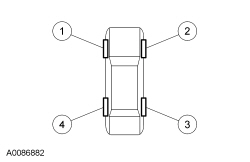
204-363

software with appropriate hardware, or equivalent scan tool
SECTION 204-04: Wheels and Tires
| 2014 Mustang Workshop Manual
|
GENERAL PROCEDURES
| Procedure revision date: 01/24/2013
|
 | Activation Tool, Tire Pressure Monitor
204-363 |
 | Vehicle Communication Module (VCM) and Integrated Diagnostic System (IDS)
software with appropriate hardware, or equivalent scan tool |
NOTE: If the vehicle has been stationary for more than 30 minutes, the sensors will go into a "sleep mode" to conserve battery power. It will be necessary to wake them up so they will transmit the latest tire pressure information to the BCM . For additional information, refer to Tire Pressure Monitoring System (TPMS) Sensor Activation in this section.
NOTE: The Tire Pressure Monitoring System (TPMS) Training procedure must be done on a single vehicle, in an area without radio frequency noise and at least 1 m (3 ft) away from other vehicles equipped with a Tire Pressure Monitoring System (TPMS).
Radio frequency noise is generated by electrical motors and appliance operation, cellular telephones, remote transmitters, power inverters and portable entertainment equipment.
NOTE: If a sensor does not respond to the Tire Pressure Monitor Activation Tool, move the vehicle to rotate the wheels at least one-fourth of a turn and attempt to activate the same sensor again. If the sensor still does not respond, attempt to activate the same sensor again using the customer activation tool (if available). If the sensor still fails to train, attempt to train the sensor with the vehicle doors open.
NOTE: The BCM has a 2-minute time limit between sensor responses. If the BCM does not recognize any 1 of the 4 tire pressure sensors during this time limit, the horn will sound twice and the message center (if equipped) will display TIRE NOT TRAINED REPEAT and the entire procedure must be repeated.
NOTE: For vehicles with different front and rear tire pressures (such as the E-Series and certain F-Series), the tire pressure sensors must be trained following a tire rotation. Failure to train the sensors will cause the TPMS indicator to illuminate. For vehicles with the same tire pressure for front and rear tires, tire rotation will not affect the system.
NOTE: Refer to Description and Operation, Push Button Start System Ignition Modules in Section 211-05 to review the procedures for achieving the various ignition states on vehicles with this feature.
NOTE:
 An animated version of this procedure is available on-line.
An animated version of this procedure is available on-line.
NOTE: It may take up to 6 seconds to activate a tire pressure sensor. During this time, the Tire Pressure Monitor Activation Tool must remain in place at the valve stem.
Place the Tire Pressure Monitor Activation Tool on the LF tire sidewall at the valve stem. Press and release the test button on the Tire Pressure Monitor Activation Tool. The horn will sound briefly to indicate that the tire pressure sensor has been recognized by the BCM .
NOTE: Do not wait more than 2 minutes between training each sensor or the BCM will time out and the entire procedure must be repeated.
Repeat Step 7 for the RR and LR tires.NOTE: This step is required to clear DTC C2780, cause the BCM to exit the manufacturing mode and to make sure there are no other concerns with a newly programmed BCM .
If the sensors are being trained due to the installation of a new BCM , clear any DTCs and carry out the BCM On-Demand Self Test.